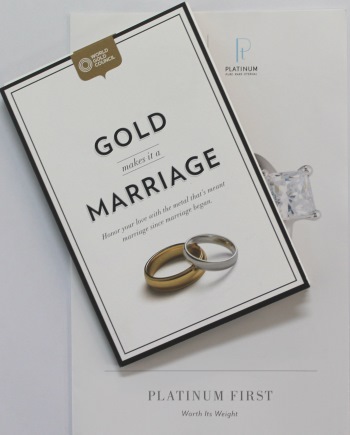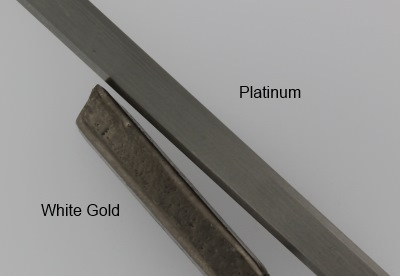How To Repair A Broken 22k Gold Middle Eastern Filigree Ring
Last week I received brochures from both The Platinum Guild and Globe Gold Quango, espousing the benefits of their corresponding metals. Still, during the purchasing process many consumers take communication from a jewellery sales person and end up bereft of whatever useful facts on the subject.

Higher up: World Gilded Council and Platinum Society Brochures
The fact of the matter is, is that both white gold and platinum both have their ain unique backdrop and hence benefits. By and large, many of these are non explained too well to the would be jewellery buyer, but are outlined below.
Hardness vs Malleability???!!!
Two backdrop of metals that aren't well understood by the jewellery industry equally a whole and jewellery consumers are hardness and malleability. In fact, when I told my ain jewellers that platinum was softer than white gold, I received goose egg but protests.
Put just, hardness refers to a metal'southward resistance to scratching and denting. A hard metal, just similar diamond, the hardest fabric known, volition be resistant to scratches, whilst a soft metal will scratch easily. Malleability refers to how easy a metal is to bend and plow into different shapes without breaking. A malleable metal will bend easily, whilst a breakable metal will not bend easily.
Whilst it may be true that platinum is harder than gold in its purest form, 18kt white gilt is mixed with other metals, nigh commonly palladium, silver and copper to make information technology harder. This results in 18kt white golden existence harder than platinum alloys, which are most commonly 95% platinum.
On the other hand, platinum is more breakable than white golden, and is hard to bend and hammer into shape, which may explain the same protests from my jewellers.
What the hardness and malleability of white gold and platinum means in real life is that a platinum ring will be easily scratched and dented, but will concord diamonds and other gemstones more securely, every bit platinum is less prone to bending due to its brittleness. However, to get the best of both worlds, we have been encouraging our clients to buy rings with a platinum setting and a white gold ring. This results in a more secure setting for the centre diamond, whilst the white gold band results in less scratches and dents.
Platinum's softness versus white aureate is also the primary reason why we don't recommend platinum for mens' nuptials rings.
Density and Weight
Platinum alloys are almost 20% denser than white gold. This results in a ring that feels more substantial, and thus more luxurious, even though it may be very fine.
Price
With the spot price of platinum and gold being very much the aforementioned present, many people ask us why platinum is nevertheless more expensive that white aureate. There are four main reasons for this:
- Platinum is denser, and thus more material weight is needed to produce the same ring than from white gold.
- Platinum alloys used in jewellery are purer. Since nearly platinum alloys are 95% platinum and 18kt white gold is 75% gilded, less gold is require to produce an 18kt white gold ring.
- Platinum is more difficult to piece of work with, and often needs a jeweller with experience to produce a good job. Therefore, the labour cost is roughly twenty% more than with white gold.
- Platinum can not be re-used and re-melted like white golden. Therefore, any scraps and filings must be sent to a refiner which is very expensive.
White Aureate Allergies
1 of the benefits espoused by The Platinum Social club is that platinum is hypoallergenic. Whilst this is true, so is most 18kt white golden, in Australia at to the lowest degree. Whilst nickel was unremarkably used to alloy white gold in the past, virtually manufacturing jewellers in Australia use a palladium based alloy that is free from nickel. However, nickel, beingness a much cheaper metal than palladium is still used widely overseas, and thus some people may suffer from nickel allergies with imported jewellery.
Colour
One of the myths about white golden is that it is slightly yellow, and thus, requires more maintenance as it needs rhodium plating every twelvemonth or 2.
Again, nickel based alloys are more likely to have a xanthous tinge, whilst palladium based alloys are more likely to have a night grey appearance when compared to platinum, as shown beneath.

Above: White gold and Platinum in foursquare wire form.
Durability
Platinum loses very piddling weight during solar day to day vesture and indeed, during polishing. Therefore, in theory a platinum ring will last a lot longer without the demand for replacing the band. However, a well fabricated ring, whether white aureate or platinum should last for generations.
Serviceability
White gold is more than widely serviceable than platinum, meaning that more jewellers are able to resize and repair white gilt jewellery. In addition to this, platinum's college melting temperature pose a risk to gemstones and diamonds that may get burnt when repairing platinum jewellery. Yet, mod tools such as light amplification by stimulated emission of radiation welders and an experienced platinum jeweller eliminate these bug.
Investment
Since gold is a widely traded asset and investment, gilt in both pure and alloy form is a lot easier to sell than platinum. Whilst numerous gold buyers have sprung upwards in recent times, very few of these buy platinum.
Source: https://www.jogiadiamonds.com.au/blog/white-gold-vs-platinum-what-jewellers-wont-tell-you/
Posted by: connhimmenting.blogspot.com


0 Response to "How To Repair A Broken 22k Gold Middle Eastern Filigree Ring"
Post a Comment